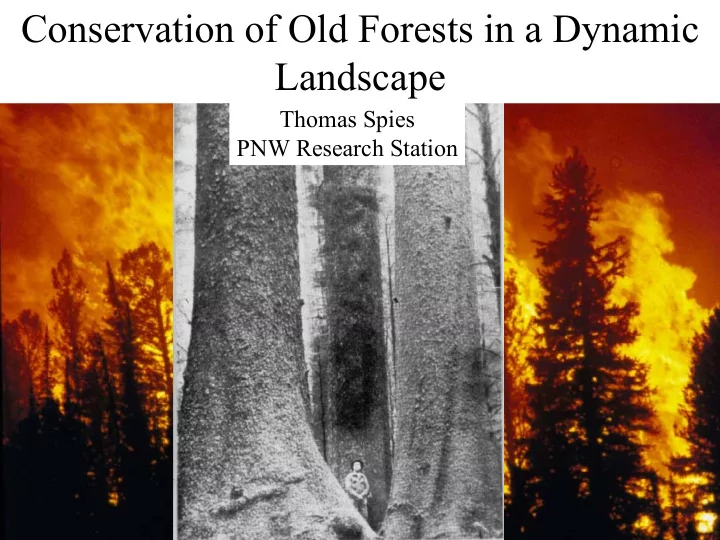

Conservation of Old Forests in a Dynamic Landscape Thomas Spies PNW Research Station
Objectives • Reserve-Matrix Concept • Short and Long-term Concerns • Discuss Alternatives
A Variety of Land Land Use Allocations Allocations With PHYSIOGRAPHIC PROVINCES 1 1. Washington Olympic Peninsula 2. Washington Western Lowlands Several Kinds of 3. Washington Western Cascades 3 4. Washington Eastern Cascades 5. Oregon Western Cascades 2 6. Oregon Eastern Cascades 7. Oregon Coast Range Reserves 4 8. Oregon Willamette Valley 9. Oregon Klamath 10. California Klamath 11. California Coast Range 12. California Cascades 8 47% of area in reserves that 7 6 Congressionally Reserved (CR) allow active management 5 Administratively Withdrawn (AW) Late-Successional Reserve (LSR*) Managed Late-Successional Area (MLSA) Matrix or Riparian Reserve (MATRR) Adaptive Management Area (AMA) Not Designated * Includes LSRs associated with marbled 9 murrelet or known owl activity centers. Also includes lands with overlapping LSR and AMA designations. 12 10 4 11 0 25 50 100 150 200 Miles 0 40 80 160 240 320 Kilometers Mapped by the Pacific Northwest Interagency Regional Monitoring Program March 11, 2005
How Have Old Forests Fared Under the Plan? • So far, so good: • Losses from logging are less than expected • Losses from wildfire less than expected • Net increase in older forest greater than what was expected
Concerns • Risk of loss of older forest and owl habitat to high severity fire • Contradictory ecological goals in dry provinces • Declines in diverse early successional stages, hardwoods, in wet provinces • Climate change effects--probably most significant in dry provinces
Fire 0 % 0 % Conditions Differ by 0 % 3.6 % Province 0 % 14 % ( incl B & B) 1.4 % 9.5 % Percent Loss of Older 3 % 2.3 % Forest on a Decadal Basis By Province 0.4 %
Fuel Reduction in Fire-prone Vegetation Types • 131,000 acres treated with mechanical or prescribed fire 2003—data is incomplete • Distribution and effectiveness? • Pre Euro-American settlement – Mean fire return intervals 3 ~ 50 years for low to moderate severity fire – Minority of landscape in dense old-growth forest types
Two Major Types of Old Growth in Fire-Prone Provinces With Fire Exclusion With frequent low-severity fire Courtesy of Norm Johnson
Hypothesized Risks of High Severity Fire and Risks to Population Viability of in Relation to Area of Dense Older Forest Risk to loss of Risk of Loss Owl Populations to High Severity Fire High High ? Low Low Dense Forest Open Forest Area of Open Forest
Wet Provinces Mature and Old Growth in High Severity and Mixed Severity Fire Regimes
Landscape Patterns in High Severity and Mixed Severity Regimes
Simulated Changes in Vegetation in Oregon Coast Range 1996 2046 2096 Declining Forest Types Dark blue = Older Conifer Yellow = young, open forest Light blue = younger conifer Red = Hardwood forests
Current Late Successional Reserve-Matrix Concept Activities Allowed : All Provinces Older Forest Thin Plantations Younger Timber Forest/Plantation Production Reserve Fire-Prone Matrix Provinces Fuel Reduction
Alternatives on Federal Lands to Current Reserve Strategy • Active management based on disturbance regimes and desired mix of seral stages • Mix of disturbance based mgt and regime and reserves • Reserve all remaining old growth
Alternative Landscape Designs for Maintaining Owl Habitat and Old-growth Diversity in Fire Prone Fuel Breaks Dense Forest Islands Forests Matrix = Owl habitat/Dense OG Matrix = Treated forest/Open OG Fuel Treatment Open Old Growth Limited or no fuel Treatment Dense Old Growth
Wet Provinces Expected Distribution of Age Classes for Forests With Infrequent Stand-Replacement Fire (200 Years) Current Percent of Landscape Structure-based Management Possible Future ~36% > 200 years 0 100 200 300 400 500 600 Forest Age
Mix of disturbance-based management and reserves • Active management produces desired seral stage diversity and landscape patterns • E.g. Blue River Landscape Study in AMA • Advantages – More control over the pattern and diversity of seral stages – More flexibility • Disadvantages – Timber production may be lower than in Plan – Still allows some cutting of older forest
Reserve all remaining old growth • No cutting of old-growth stands (wet provinces) and/or trees over a certain size (dry provinces) • Elements of option 1 in FEMAT OG Reserve • Advantages – Lowest risk to old-growth forest species – Cutting in plantations to produce wood and create early successional habitat • Disadvantages – Less timber production – Defined by current patterns – Road systems?
Summary • Reserves are not all passive management areas • So far so good—but short and long-term concerns remain • Landscape-level alternatives for dry provinces may be more effective at meeting Plan goals • Some alternatives for wet provinces could improve seral stage diversity—but not as urgent
Recommend
More recommend